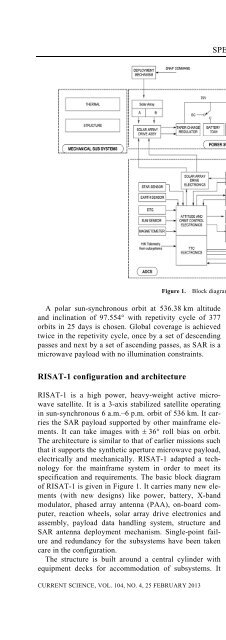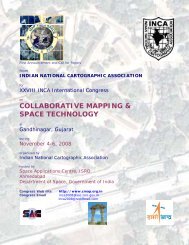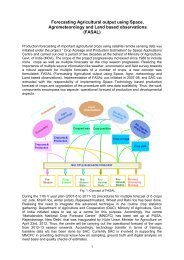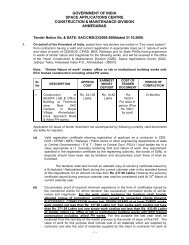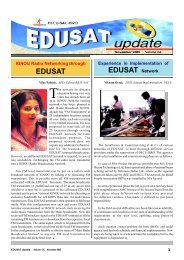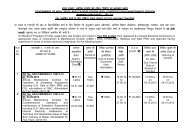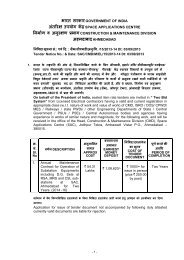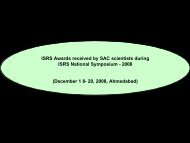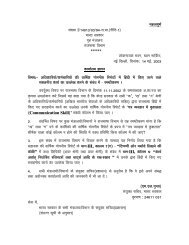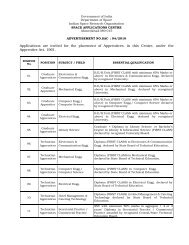Special Issue on RISAT-1, Current Science, 25 March 2013 - Space ...
Special Issue on RISAT-1, Current Science, 25 March 2013 - Space ...
Special Issue on RISAT-1, Current Science, 25 March 2013 - Space ...
- No tags were found...
You also want an ePaper? Increase the reach of your titles
YUMPU automatically turns print PDFs into web optimized ePapers that Google loves.
SPECIAL SECTION: RADAR IMAGING SATELLITE-1Figure 1.Block diagram of <strong>RISAT</strong>-1 spacecraft.A polar sun-synchr<strong>on</strong>ous orbit at 536.38 km altitudeand inclinati<strong>on</strong> of 97.554° with repetivity cycle of 377orbits in <strong>25</strong> days is chosen. Global coverage is achievedtwice in the repetivity cycle, <strong>on</strong>ce by a set of descendingpasses and next by a set of ascending passes, as SAR is amicrowave payload with no illuminati<strong>on</strong> c<strong>on</strong>straints.<strong>RISAT</strong>-1 c<strong>on</strong>figurati<strong>on</strong> and architecture<strong>RISAT</strong>-1 is a high power, heavy-weight active microwavesatellite. It is a 3-axis stabilized satellite operatingin sun-synchr<strong>on</strong>ous 6 a.m.–6 p.m. orbit of 536 km. It carriesthe SAR payload supported by other mainframe elements.It can take images with ± 36° roll bias <strong>on</strong> orbit.The architecture is similar to that of earlier missi<strong>on</strong>s suchthat it supports the synthetic aperture microwave payload,electrically and mechanically. <strong>RISAT</strong>-1 adapted a technologyfor the mainframe system in order to meet itsspecificati<strong>on</strong> and requirements. The basic block diagramof <strong>RISAT</strong>-1 is given in Figure 1. It carries many new elements(with new designs) like power, battery, X-bandmodulator, phased array antenna (PAA), <strong>on</strong>-board computer,reacti<strong>on</strong> wheels, solar array drive electr<strong>on</strong>ics andassembly, payload data handling system, structure andSAR antenna deployment mechanism. Single-point failureand redundancy for the subsystems have been takencare in the c<strong>on</strong>figurati<strong>on</strong>.The structure is built around a central cylinder withequipment decks for accommodati<strong>on</strong> of subsystems. Ithas a unique structure carrying elements of bus systemand payload system which is different from earlier remotesensing missi<strong>on</strong>s. The spacecraft bus subsystems providebasic housekeeping functi<strong>on</strong>s like orbit correcti<strong>on</strong>, attitudedeterminati<strong>on</strong>, thermal c<strong>on</strong>trol, electrical power generati<strong>on</strong>and distributi<strong>on</strong>, ground communicati<strong>on</strong>s, SARimage data handling and storage and data transmissi<strong>on</strong> tothe ground. The bus module c<strong>on</strong>tains all the necessarysystems to operate and maintain the spacecraft in orbitand support the SAR payload. The overall mechanicalc<strong>on</strong>figurati<strong>on</strong> of <strong>RISAT</strong>-1 is simple and efficient. It alsosatisfies the envelope and Centre of Gravity (CG) c<strong>on</strong>straints/requirementsof the launch vehicle. PSLV-XLwas the launch vehicle for <strong>RISAT</strong>-1 spacecraft.Stowed c<strong>on</strong>figurati<strong>on</strong> of <strong>RISAT</strong>-1 at the launch padinside Polar Satellite Launch Vehicle (PSLV) is shown inFigure 2 and the deployed c<strong>on</strong>figurati<strong>on</strong> of <strong>RISAT</strong>-1 isshown in Figure 3.<strong>RISAT</strong>-1 designStructureThe structure is designed to meet the stiffness, strengthand pointing requirements of the payload, sensors andalso c<strong>on</strong>fining the overall bus volume within the launchvehicle envelope. It is based <strong>on</strong> a single bus c<strong>on</strong>cept builtaround a central cylinder. A truncated triangular structureis built around the cylinder to hold the SAR antenna andCURRENT SCIENCE, VOL. 104, NO. 4, <strong>25</strong> FEBRUARY <strong>2013</strong> 463


